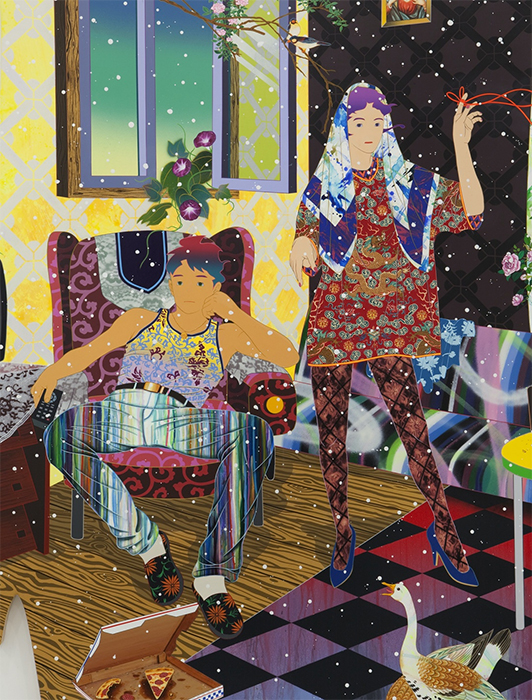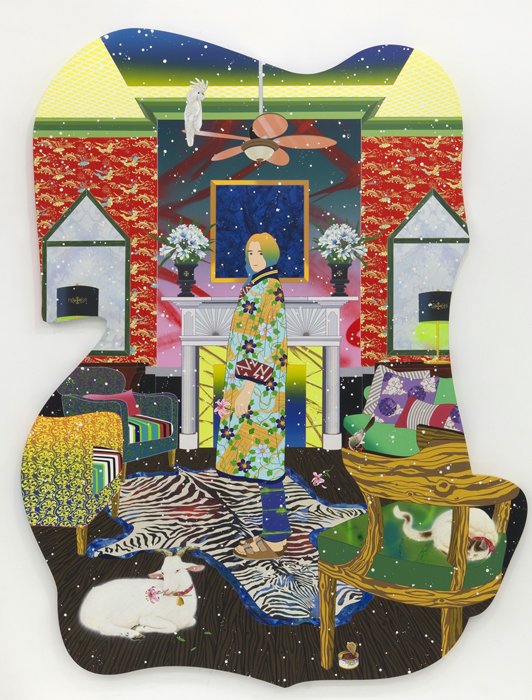“The convenience of our time has made how layered our culture is indefinite. When we see an image, we try to find connections. I accumulate all of this visual dialect and bring it together as though it has meaning, and the viewers make up a story based on their upbringing.”
– Tomokazu Matsuyama
A first-generation Japanese American who lives and works in New York City, Tomokazu Matsuyama (b. 1976, Gifu, Japan) has developed a singular aesthetic grounded in an elegant expression of what he refers to as “the struggle of reckoning the familiar local with the familiar global.” As a bi-cultural visual artist, he is keenly aware of the nomadic diaspora, a community of wandering people who seek to understand their place in a world full of contrasting visual and cultural dialects.
Though he manages a dynamic, wide-ranging, and truly global practice that includes painting, sculpture, and large-scale public works, Matsuyama notably remains dedicated to furthering the most personal and intimate aspects of his aesthetic evolution. Each painting that leaves his studio is the fulfillment of hundreds of hours of work, as intensive research into source imagery converges with the application of innumerable layers of custom-blended paint. The astoundingly vivid surfaces of his paintings project an almost digital brilliance, yet, upon close inspection, a painterly reality becomes clear, as hand-made brush strokes intermingle with delicately drawn figures, gestural splotches, and drips, and meticulously spray-gunned backgrounds.
Matsuyama’s works feature amalgams of references, including figures borrowed from fashion magazines; clothing reminiscent of historic Japanese garments; backgrounds evocative of Shogun-era screens and panels; curved canvases that simultaneously recollect mid-century Modernist Minimalism and the far more ancient history of shaped tea platters; and elements such as a junkyard tire and a bag of potato chips that situate the images starkly in the present age, and spotlight popular culture as embodied by mass-produced commodities.
“The convenience of our time has made how layered our culture is indefinite,” says Matsuyama. “When we see an image, we try to find connections. I accumulate all of this visual dialect and bring it together as though it has meaning, and the viewers make up a story based on their upbringing.”
By raising questions of national and individual identity through the formal qualities and subject matter of his paintings, Matsuyama examines the “natural chaos” of our social environments and challenges viewers to confront their own conceptions of cultural homogeneity.
Matsuyama received his MFA in Communications Design from the Pratt Institute, New York. Recent exhibitions include Realms of Refuge, Kavi Gupta, Chicago, IL; Tomokazu Matsuyama: Accountable Nature, Long Museum West Bund, Shanghai, China; Tomokazu Matsuyama: No Place Like Home, Zidoun-Bossuyt Gallery, Luxembourg; Tomokazu Matsuyama: Oh Magic Night, Hong Kong Contemporary Art (HOCA) Foundation, Repulse Bay, Hong Kong; Edo Pop: The Graphic Impact of Japanese Prints, Japan Society, New York, NY, USA; Tomokazu Matsuyama: Palimpsest, Harvard University, Cambridge, MA, USA; Thousand Regards, Katzen Arts Center at American University Museum, Washington, DC, USA; and Made in 17 hours, Museum of Contemporary Art Museum, Sydney, Australia, among others.
Public displays of Matsuyama’s work include a monumental, permanent sculptural installation, activating Shinjuku Station East Square, Tokyo, Japan, one of the busiest urban train stations in the world, as well as acclaimed, large-scale public commissions in Beverly Hills, CA, and in the Bowery neighborhood of Manhattan, mobilizing Matsuyama’s signature examinations of bi-cultralism and pop culture.
Matsuyama’s works are in the permanent collections of the Long Museum, Shanghai, China; LACMA, Los Angeles, CA, USA; Asian Art Museum, San Francisco, CA, USA; and The Dean Collection (Swizzbeats and Alicia Keys), USA; among many others.



